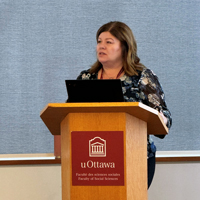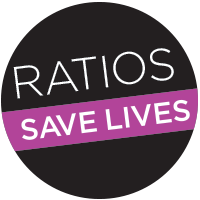 Leading by Example
Leading by Example

As BC takes bold steps to implement minimum nurse-to-patient ratios (mNPR), the rest of the country is taking notice.
Last fall, BCNU participated in two major national events showcasing the union’s leadership in securing and implementing mNPR in British Columbia. This innovative policy solution – the first of its kind in Canada – promises to dramatically enhance patient care while improving nurses’ working conditions.
At the inaugural National Nurse- Patient Ratios Summit, hosted by the Canadian Federation of Nurses Unions (CFNU) in Ottawa on Nov. 27, BCNU’s experience was front and centre. As the first province to implement mNPR, BCNU’s work serves as a blueprint for nurses’ unions across the country, many of whom are grappling with staffing crises in their home provinces.
The summit brought together union leaders, policymakers and frontline nurses to discuss the opportunities and challenges of implementing ratios at the provincial level. Topics included legislative advocacy, funding mechanisms and the practical steps for introducing ratios in different health-care settings.
CFNU President Linda Silas applauded the progress made in BC, stressing the importance of addressing the national and international nurse staffing crisis. “The nurse staffing crisis knows no borders. We are facing a global nursing shortage, and safe nurse staffing is critically important,” said Silas. “Safe staffing models are being brought into effect in British Columbia and Nova Scotia, and we know strong implementation is critical to success.
Working together, we can solve the nursing shortage with tangible, evidence-based solutions.”
BCNU President Adriane Gear’s presentation, “Implementing Minimum Nurse-to-Patient Ratios: The BC Experience,” recounted the years of advocacy, research and collaboration to secure mNPR in the province. She highlighted the union’s ongoing efforts to hold the government accountable for successfully implementing this critical initiative.
“This achievement is the result of years of hard work and leadership by BCNU members,” said Gear. “We’re proud to share our experiences and to learn from others. Together, we can build a stronger, safer health-care system for nurses and patients everywhere.”
International Perspectives on mNPR
Professor Jane Ball, a globally respected health-care researcher and head of the United Kingdom’s Institute of Nursing Excellence, also presented at the summit. Drawing from extensive international studies, she stressed that safe staffing is not just convenient – it’s a matter of life and death.
Ball’s research revealed a striking 11 percent reduction in the odds of mortality among surgical patients in hospitals with two fewer patients per nurse. Similarly, hospitals with more favourable nurse work environments saw a 13 percent decrease in the odds of patient deaths. When hospitals excelled in three areas – lower patient-to-nurse ratios, better work environments and more educated nursing staff – the odds of surgical patient mortality dropped by approximately 30 percent.
Ball also drew attention to the concept of “missed care.” These are the tasks that nurses struggle to complete when they are under-staffed, such as patient monitoring, medication administration and emotional support. Studies have shown that essential care activities often go undone when nurses are stretched too thin. This missed care directly impacts patient safety, with a 10 percent increase in missed care associated with a 16 percent increase in mortality rates.
“Our nurses are doing more than improving health care in BC – they are also helping shape the future of Canada’s health-care system.”
- BCNU President Adriane Gear
The implications of missed care are far-reaching, affecting patient outcomes and contributing to nurse burnout and job dissatisfaction.
However, as Ball’s research made clear, these challenges are not insurmountable. By implementing evidence-based solutions like nurse-to-patient ratios, health-care systems can address these systemic issues and create safer environments for patients and nurses.
BCNU Members Share Insights
BCNU West Kootenay regional council member Shalane Wesnoski, Pacific Rim regional council member Kelley Charters and BCNU Vice President Tristan Newby attended the summit. They described the atmosphere as momentous and filled with a sense of purpose among attendees who were passionate about developing a national framework for nurse-to-patient ratios.
The discussions over the two-day summit highlighted the shared challenges provinces face and the critical role of working together in finding solutions. Wesnoski found inspiration in the collective recognition of the progress being made in BC. “There was a real sense of pride in what we’re accomplishing,” she said. “But more importantly, there was an understanding that this work isn’t just for us – it’s for the entire country. The rest of Canada is watching and eager to follow our lead.”
Charters described a particularly meaningful moment when presenters shared research demonstrating the long-standing benefits of nurse-to-patient ratios. “The data presented was the same data BCNU cited over a decade ago during arbitration to stop cuts to nursing,” she explained. “It’s been consistent for years – adding nurses improves patient outcomes.
Seeing that evidence reaffirmed was a full-circle moment for me.”
The summit also fostered collaboration among nursing unions and experts. Wesnoski noted that attendees from other provinces were eager to connect with BC nurses and learn from their experiences. “People kept coming up to us, asking, ‘What are you doing in BC?’ because they wanted to bring those strategies home,” she said.
Wesnoski summed up the lasting impact of the summit: “This is legacy work. We are fundamentally changing how health care will be delivered – not just in BC, but across the country.”
BCNU Inspires Action at Canadian Health Workforce Conference
The next day, Gear spoke at the 10th annual Canadian Health Workforce Conference at the University of Ottawa. This key event brings together researchers and health-care professionals to address workforce planning and staffing challenges.
Attendees from across Canada expressed keen interest in how BC’s model could help address their staffing shortages and growing demands on the health-care system.
“Our nurses are doing more than improving health care in BC – they are also helping shape the future of Canada’s health-care system,” Gear said. “By sharing our experience, BCNU members are contributing to a stronger, more sustainable system for nurses and patients across the country.”
“This work isn’t just for us – it’s for the entire country. The rest of Canada is watching and eager to follow our lead.”
- Shalane Wesnoski
Work Continues
As BC moves forward with mNPR, the province is making a major shift in health-care policy at home while inspiring change in other provinces – and around the world. This initiative proves that real change is possible when people work together. But the work isn’t finished. Holding health authorities accountable, reporting staffing shortages and continuing to push for improvements will take ongoing effort.
This change is about more than numbers – it’s about improving the culture of health care in BC. It’s about creating a system that values nurses, prioritizes patient safety and sets a higher standard for care. There is still work to be done, but with continued effort, a safer and more sustainable health-care system is finally within reach.
Nurse Hiring Delays
While implementing ratios is an important step forward, success depends on having enough nurses in place. Unfortunately, BCNU continues to receive reports of qualified nurses facing delays in being hired by BC health authorities.

To better understand the issue, BCNU launched a campaign to collect firsthand accounts from nurses who have experienced hiring delays. New graduates, internationally trained nurses and experienced nurses transferring between health authorities have all reported long waits before securing employment, raising concerns about inefficiencies in the hiring process. SHARING SOLUTIONS BCNU President Adriane Gear attends the 10th annual Canadian Health Workforce Conference at the University of Ottawa, sharing insights on the work to implement minimum nurse-to-patient ratios in British Columbia and their potential impact on staffing and patient care.
These delays raise serious questions about whether current hiring practices are helping or hindering efforts to address staffing shortages. BCNU is gathering these experiences through a confidential reporting system at bcnu.org, providing nurses with a way to share their concerns. This information will help build a clearer picture of the problem and support efforts to improve hiring practices.
“Addressing hiring delays is essential to making sure nurse-to-patient ratios improve care and working conditions across BC,” said Gear. “We cannot let unnecessary delays slow down our progress.”
The stories gathered will assist the union in bringing this issue directly to the Ministry of Health and continuing to advocate for a more efficient hiring process and real, tangible solutions to the nurse staffing crisis. •
UPDATE (Spring 2025)

JOIN THE RATIOS MONITORING TEAM
As the rollout of minimum nurse-to-patient ratios (mNPR) continues, BCNU has launched a monitoring initiative to collect data and first-hand experiences from nurses across the province. This effort will assess how well ratios are being implemented and pinpoint areas needing improvement.
BCNU CEO Jim Gould emphasized the critical role nurses play in this process.
“Nurses in every health authority and care setting are essential to holding employers accountable. Your experiences will help us determine whether these ratios are properly enforced and identify where changes are needed.”
BCNU encourages members to get involved by joining focus groups, sharing feedback through surveys and monitoring how ratios are being applied in their workplaces.

